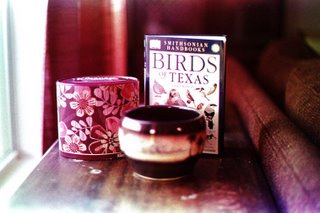Color images from black and white film
There is a fascinating online photographic exhibit of color images taken in pre-WWI Russia called The Empire That Was Russia. The photographer, Sergei Mikhailovich Prokudin-Gorskii, would shoot a scene three times, each time through a different colored filter (red, green, and blue). After the plates were developed, he'd project each one through the same colored filter, combining the projected images into a single, full-color image. It's a wonderfully geeky trick, and the resulting images are gorgeous.
I decided to try it out for myself. I loaded up the Nikon FE with a roll of Tri-X (ISO 400 black and white film) and shot three frames, each through a red, green, and blue filter1. Here are the original frames:

From left to right, it's the blue filter, green filter, and red filter.
The next step was to combine them. I fired up the Gimp (open source equivalent to Photoshop) and opened each frame as a separate layer in a new image in additive mode. I nudged each layer so that they lined up exactly, then colorized each layer by opening the Color Balance tool and adjusting the color for the midtones (red for the red layer, green for the green layer, etc.). I left the shadows and highlights alone. Since the layers were additive, and each layer was a normal exposure, the result looked heavily overexposed (by 2 stops, go figure). I had to radically adjust the curves for each layer, flattening them out as much as possible.
Once I was done, I had a passable result:

Depending on your monitor settings, the result may look a little red to you, but it's a proof of concept. I doubt I'm going to do this very often (after all, color film exists for a reason), but it was a fun experiment. What I need to do next is colorize each layer to a "wrong" color (red as green, green as blue, blue as red) and see what kind of results I get.
1. Actually, a daylight correction filter for shooting daylight balanced film under tungsten light, but good enough for this purpose.
I decided to try it out for myself. I loaded up the Nikon FE with a roll of Tri-X (ISO 400 black and white film) and shot three frames, each through a red, green, and blue filter1. Here are the original frames:

From left to right, it's the blue filter, green filter, and red filter.
The next step was to combine them. I fired up the Gimp (open source equivalent to Photoshop) and opened each frame as a separate layer in a new image in additive mode. I nudged each layer so that they lined up exactly, then colorized each layer by opening the Color Balance tool and adjusting the color for the midtones (red for the red layer, green for the green layer, etc.). I left the shadows and highlights alone. Since the layers were additive, and each layer was a normal exposure, the result looked heavily overexposed (by 2 stops, go figure). I had to radically adjust the curves for each layer, flattening them out as much as possible.
Once I was done, I had a passable result:

Depending on your monitor settings, the result may look a little red to you, but it's a proof of concept. I doubt I'm going to do this very often (after all, color film exists for a reason), but it was a fun experiment. What I need to do next is colorize each layer to a "wrong" color (red as green, green as blue, blue as red) and see what kind of results I get.
1. Actually, a daylight correction filter for shooting daylight balanced film under tungsten light, but good enough for this purpose.
Labels: photography


0 Comments:
Post a Comment
<< Home